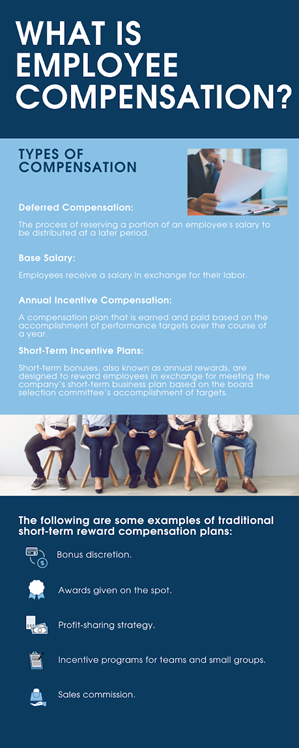A Compensation Glossary
Total Compensation:
An employee’s total pay package includes their base compensation, often known as their base salary, as well as the value of their benefits package. Health insurance, a retirement plan, paid time off (PTO), life insurance, overtime pay, perks, profit sharing, stock options, and any bonuses or variable incentive pay can all be included in this benefits package. Every company’s optimal executive overall pay approach is different. While remaining competitive with other firms in your sector, each company must discover the proper balance between employee compensation in base pay and employee benefits in their compensation strategy. The right pay mix of base salary, benefits, and other compensation attracts and retains employees.
How to determine compensation?
It’s critical to figure out a compensation structure for your employees that is in line with your company’s objectives. To build a full picture of payment methods, wages, and benefits throughout your sector, you must analyze rivals’ salary ranges in conjunction with their benefits and incentive schemes. Make sure to research different geographic areas and what wage levels are successful in each. In big businesses, a compensation department should be hired to oversee the establishment and evolution of wage compensation packages.
Types of Compensation
Deferred Compensation: The process of reserving a portion of an employee’s salary to be distributed at a later period is known as deferred compensation. These payments are generally made in the form of pensions, retirement programs, or stock options. Taxes on deferred compensation plans are not paid until the funds are distributed. Deferred compensation plans, commonly known as DCPs or elective deferral programs, are a type of deferred compensation plan (EDPs).
Base Salary: Employees receive a salary in exchange for their labor. Depending on job function and title employees may receive salary or hourly payments but must receive at least minimum wage. Base salary is the initial salary paid to an employee, usually negotiated at the time of hire or promotion, and excludes any bonuses, incentives, or other compensation benefits. Base salary is determined by a combination of factors such as cost of living, experience, and the employee’s own negotiation.
Annual Incentive Compensation: An annual incentive plan is a compensation plan that is earned and paid based on the accomplishment of performance targets over the course of a year. These strategies encourage executive performance and match their efforts with the company’s short-term objectives. Annual performance incentive compensation in a well-designed compensation program will contain targets that complement the company’s long-term business goals and strategy. Senior management and executive opportunities are frequently specified as a percentage of base pay.
Short-Term Incentive Plans: Short-term bonuses, also known as annual rewards, are designed to reward employees in exchange for meeting the company’s short-term business plan based on the board selection committee’s accomplishment of targets.
The following are some examples of traditional short-term reward compensation plans:
Bonus discretion. After a cycle, management decides the duration of the incentive pool and the sums to be distributed to individuals. This strategy is not promised and has no fixed formula or guarantees.
Awards given on the spot. Recognize unique contributions as they happen with a goal or project, which is usually completed in a limited amount of time.
Profit-sharing strategy. Employee benefit sharing is a strategy in which workers share in the company’s earnings. A fixed, specified formula is usually included in the schedule for allocating benefit shares to participants and distributing funds collected under the plan. Other schedules, on the other hand, are optional.
Incentive programs for teams and small groups. Any reward scheme that focuses on a small group’s success, typically a work squad. When observable success is the product of collective action and it is impossible to distinguish individual inputs, these systems are often used.
Sales commission. A commission is a sort of payment that is based on volume, income, or a specific degree of performance. When it comes to commission payments, there are two common methods. The quantity of services or items given determines the commission rate. The second technique is based on sales objectives and the number of sales made. A real estate broker is an example of a worker who is compensated in this way: they sell a home and get paid for it. It makes no difference how long it took to sell the house or what work activities were involved; the fact that the house was sold is all that matters.
Compensation and Benefits:
Employee Benefits Package
Salary Range: It’s critical to figure up a compensation structure for your employees that is in line with your company’s objectives. To build a full picture of pay methods throughout your sector, you must analyze rivals’ pay ranges in conjunction with their benefits and incentive schemes. Make sure to research different geographic areas and what wage levels are successful in each. In big businesses, a compensation department should be hired to oversee the establishment and evolution of wage compensation packages.
Retirement Plans
401(k): A 401(k) plan is a type of retirement savings plan that is heavily regulated and sponsored by an employer, with matching contributions frequently made. Deferred compensation is a method in which an employee saves for future expenses by postponing a portion of their pay to a later period, generally after retirement. Deferred compensation programs are less restrictive than traditional 401(k) plans, but they are also riskier.
Stock Options: Stock options and stock-settled appreciation rights are two types of stock options. Stock options provide you the right to buy shares of a company’s stock at a certain price (exercise price) for a set amount of time (term). SARs or stock-settled appreciation rights are a little different. In a SAR, the participant receives value only if the stock increases in value from the date of the award. If this is the case, an option will have an exercise price. In principle, SARs are similar to stock options; but, when they are settled, you only receive the profit in shares.
Enterprise Compensation: Traditional pay packages for hourly employees or salaried managers and practitioners range substantially from executive remuneration. The incentives for genuine performance and outcomes are heavily weighted in executive remuneration. When a company underperforms, however, the leaders’ salaries are often lowered to a percentage of their prospective compensation or compensation objectives. Executives will be compensated substantially more if a business meets or surpasses its yearly targets and the stock price grows over time.
Clawbacks: Bonus payments are frequently regulated by clawback clauses in financial employment agreements. Many bonuses in complex financial instruments are paid out years after the products are created. If an employee’s performance metrics drop, if they resign before a particular date, or if a client churns within a specific time or fails to pay an invoice, the clawback clause forces them to repay a portion of their compensation or stock options.
Fringe Benefits: Today, pay practices have changed. Benefits, perquisites, and incentive pay account for a smaller proportion of total compensation for executives. The level of shareholder dissatisfaction far exceeds the importance of the benefits/perks provided, and the focus has shifted to “irritants.” Today’s perks are usually supportive of executives’ well-being and productivity. SERPs (Supplemental Executive Retirement Plans) that provide additional perks to senior executives, such as personalized retirement plans, are under fire. The use of excess/restoration plans is also permitted. Severance and change-of-control incentives are being used to address pay-for-non-performance problems.




